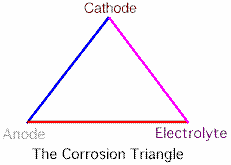Exfoliation corrosion, also known as, lamellar or layer corrosion refers to intergranular corrosion that takes place in boundaries of aluminum grains especially in the fuselage empennage and wing parts of airplanes. Due to the procedures involved in rolling, the grain boundaries are arranged in a manner that they are directly opposite to the surface of the material. This type of corrosion is mostly found in zippers where an electrically shielding sealant is broken down hence allowing a galvanic action to occur between the different metals. In cases where fasteners are a major component of the corrosion process, then exfoliation extends in such a way that it is far from the fastener hole. In other cases, the surface protrudes outwards and the absence of telltale blisters, which can only be identified through constructive inspection methods, is quite rare (Davis, 2001).
The products of corrosion, which build up in the grain margins, exert pressure amidst the grains and these results to a ‘leafing effect’. The extensive force of unsolvable products of corrosion tends to separate the grains leading to exfoliation corrosion. Extruded aluminum alloys with long and flattened grains are prone to damages caused by this phenomenon (Fontana, 1986).

Dezincification corrosion
Densification corrosion is a type of selective corrosion that occurs when zinc metal is percolated from its alloy and this leaves a weakened permeable fitting of copper. The phenomenon is very common in chlorinated water or in water containing large quantities of oxygen and carbon dioxide. The signs of densification corrosion include the presence of a white powdery coating of zinc oxide on the surface or color change of brass from yellow to red. Densification corrosion is detrimental especially when it makes a fitting weak and susceptible to failure and leakages.
This type of corrosion is mostly found in brass, which is an alloy of copper and zinc. This is because brass as a metal is malleable and is easy to cast. When the alloy is composed of about 15% zinc, then this increases the risk of densification corrosion since zinc is highly reactive and its atoms are weakly bonded. Low amounts of copper in brass decrease the rate at which densification corrosion occurs (Garverick, 1994).
Inhibitors of Exfoliation Corrosion and Dezincification corrosion
Inhibitors of densification corrosion and densification corrosion are compounds that when mixed with gases or liquids, decrease the rate at which densification corrosion of the brass alloy occur. The efficiency of these inhibitors are depended on the composition of the fluids, amount of water and flow rate.
In brass tubes, an alloy of arsenic brass is used to shield the tubes from external densification corrosion, which in many causes arises from excessive exposure to road salts in areas such as Toronto and Montreal in Canada. This inhibitor is very effective in inhibiting densification corrosion and its inhibition efficiency does not drop even when under conditions of dynamic flow (Moncmanová, 2007).
Manufacturers also use small amounts of other metal elements as inhibitors in an attempt to ward off corrosion. Such elements include phosphorous, tin and antimony though antimony has proved to be very effective. Corrosion resistant brass is also used as an inhibitor of densification corrosion (Garverick, 1994).
The role of Cathodic Protection in Preventing Exfoliation Corrosion and Dezincification corrosion
Cathodic protection is an electrochemical process used in reducing the detrimental effects of densification corrosion. The process reduces the anodic dissolution of metals by minimizing the electrical potential power differences between both the anode and cathode parts of a metal. It is achieved when the open circuit ends of the cathode are polarized to the anode. The cathode in this case acts as a current receiver while the anode acts as a current provider. The National Association of corrosion engineers (NACE) states that corrosion engineers must be careful when choosing the level of cathodic protection needed on a metal (Moncmanová, 2007).
Cathodic protection is divided into two: sacrificial anode cathodic protection and impressed current cathodic protection. Sacrificial anode cathodic protection is made up of metal alloys especially those of zinc and aluminum. Different electrolytes, which include seawater, oil, and concrete, are used depending on the alloy (Garverick, 1994). Each anode provides cathodic protection since it has large quantities of electrical energy. The Galvanic series helps the engineer in choosing the anode required for cathodic protection (Davis, 2001).
In impressed current cathodic protection, the anodes, which in most cases are inert, are supplied with electrical energy by an exterior DC current. The anodes used in this type of cathodic protection include graphite and iron which has been cast (Cheremisinoff, 2010).
The role of Coating in Preventing Exfoliation Corrosion and Dezincification corrosion
Coating is a common mechanism for preventing both exfoliation and dezincification corrosion. It involves the formation of a pervasive layer, which inhibits the access of the substance causing corrosion to the metal. Powder coatings are applied to the surface of the metal and this enhances the aesthetic appearance of the metal. It hinders the corrosion habit found in most commercial metal elements that are used in the construction of structures and fabrication. Coating acts as a barrier between the element and the electrolyte (Davis, 2000).
Copper is also a good example of an effective anti-corrosion coating that is used to prevent both exfoliation and dezincification corrosion. Various protective coatings have been realized and conducted tests show that they are efficient in preventing corrosion. Preliminary results with coatings that are chemically grafted have been found to be promising and the already existing coating solutions are being assessed to test their effectiveness in preventing Exfoliation Corrosion and Dezincification corrosion (Fontana, 1986).
References
Cheremisinoff, P. (2010). A Guide to Safe Material and Chemical Handling. Hoboken: Scrivener Pub.
Davis, R. (2000).Corrosion: understanding the basics. Ohio: ASM International.
Davis, R. (2001).Surface engineering for corrosion and wear resistance. Great Britain: ASM International.
Fontana, G. (1986). Corrosion engineering. New York: McGraw-Hill
Garverick, L. (1994). Corrosion in the petrochemical industry. Materials Park: ASM International.
Moncmanová, A. (2007).Environmental deterioration of materials. Southampton: WIT Press.